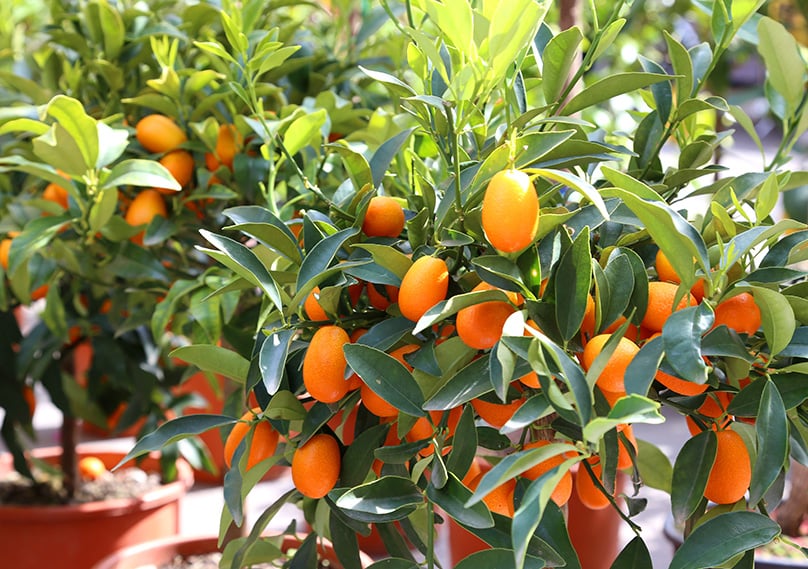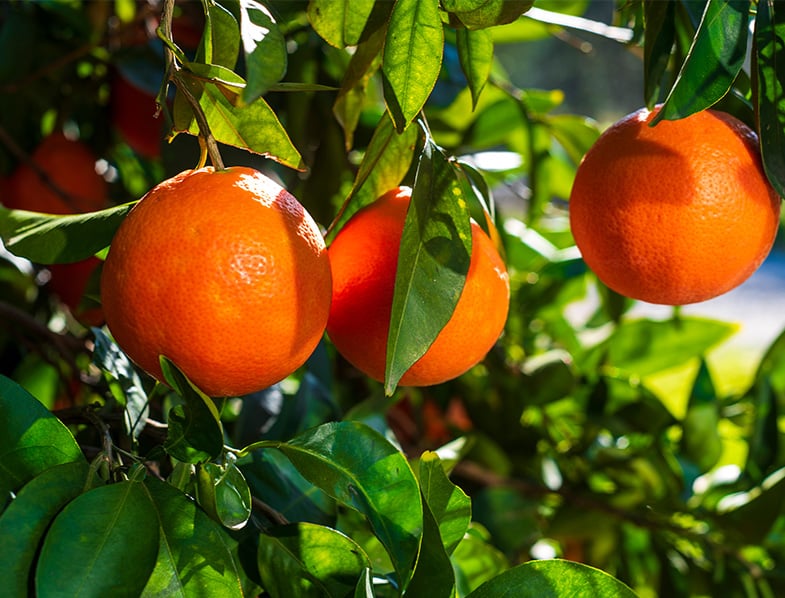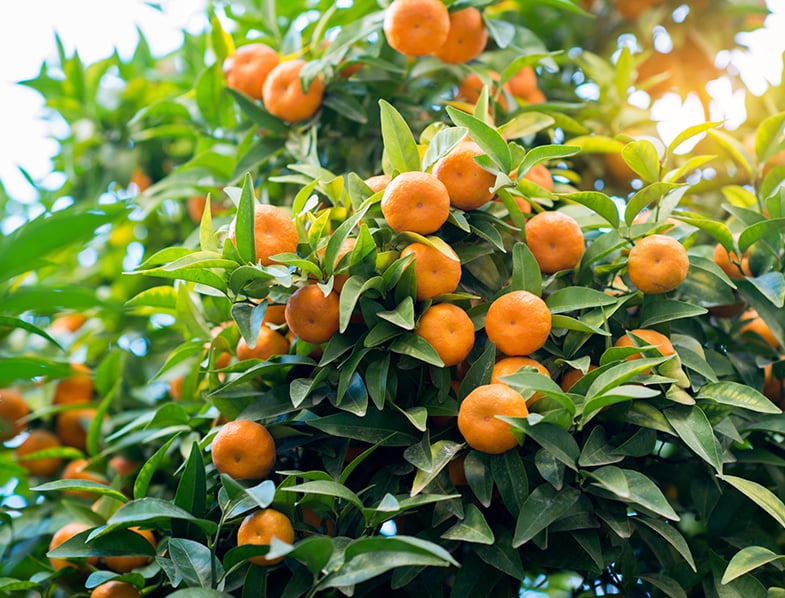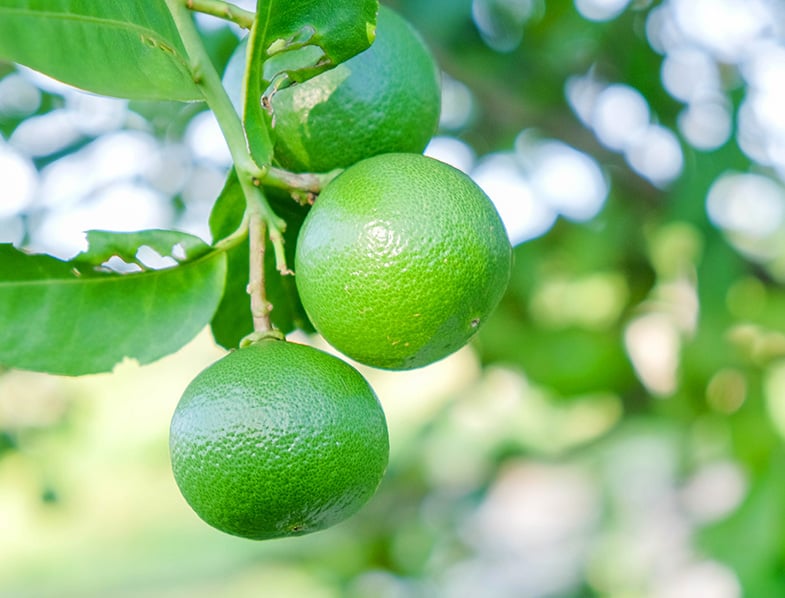Whether you refresh yourself during summer with a tasty cold drink made of citrus fruits or you peel some oranges or mandarins during Christmas, there is no doubt that these fantastic fruits are an all-time favourite, loved by many individuals. You can prepare delicious desserts from some of them, such as key lime pie, or use them in tarts, such as kumquats.
There is no doubt they are delicious, given their sweet, and at times a bit sour, juices. In the case of limes or lemons, they aren’t as much eaten by themselves as they are incredibly sour. Nonetheless, they make excellent additions as ingredients in various recipes. Take the famous and highly delicious guacamole – it wouldn’t taste as good without limes or lemons.
Without further ado, let’s briefly discuss citrus trees. You can find out the most fundamental requirements for these flowering trees and shrubs before diving into our selection of ten of the most interesting as well as common citrus trees.
Keep reading to find out more about these beautiful citrus trees.
What Are Citrus Trees?
Citrus Trees are part of the Citrus genus of the Rutaceae family. These flowering trees produce fruits of different flavours, mostly sweet, sour, with some of them having particular tastes not resembling other fruits. Some of the most known citrus fruits include oranges, mandarins, lemons, limes, and pomelos. However, there are many more species and varieties that have different planting and growing requirements. For instance, some people may not know that kumquats are also a type of citrus tree.

More specifically, there are 100 different citrus tree varieties and around 60 species in the Citrus Genus. Another interesting fact about these trees is that they can be found in various countries and have been cultivated around the world over the centuries. Therefore, native to Asia and heavily grown in various Asian countries to this day, citrus trees can also be found from the Mediterranean countries in Europe to Florida, California, and Arizona in the USA.
Needless to say, citrus trees are fascinating, both in their appearance and evolution, with their fruits continuing to be incredibly popular to this day, given their taste as well as health benefits.
What Are the Requirements for Growing Citrus Trees?
Planting and growing citrus trees are quite similar for most species, with a few exceptions here and there. Generally, the majority of citrus trees prefer growing in an area where there is full sun exposure. In some cases, there are citrus trees that can do well in part shade, with some varieties being quite hardy. But even if some prefer shade, citrus trees have zero tolerance to frost, with many being harvested before the first frost hits.
Because citrus trees can easily cross between species, there are many hybrid variations. For instance, even the grapefruit is a hybrid plant that appeared accidentally by crossing sweet orange and pummelo. This happened a long time ago in Barbados and has since become one of the most grown citrus trees, being many people’s favourite.
Another common trait for most citrus trees is they all need well-drained soil that is maintained moist at all times. Under no circumstance should you plant any variety of citrus trees in wet soils. They won’t be able to grow. Sandy loam soil is the type that works best, with clay also being accepted, provided you ensure proper irrigation.
Another vital aspect to mention when it comes to growing citrus trees is fertilization. It is essential to fertilize citrus trees, especially the young ones which are still developing. Once the citrus tree becomes more established, you can reduce how many times you fertilize it.
As you have discovered so far, there are many types of citrus trees, counting hybrids as well, given that the species can be easily crossed. Keep reading to find out more about ten of the most interesting types of citrus trees.
1. Moro Blood Orange
There is the standard blood orange, and there is the Moro blood orange, one of the most known and interesting-looking orange varieties. It is extremely popular for the colour of its flesh, a deep red almost close to burgundy, with a deep purple tint when the tree is grown in even warmer areas. It truly stands out, not just because of its unique colouring but also because it has a special aroma and a berry-like flavour. We are sure this is not how you usually hear an orange being described.

The Moro blood orange, and most of the blood orange citrus trees, have this exceptional colouring because of a substance called anthocyanin. This is usually present in some flowers and never in citrus trees, apart from the blood orange variety, which contains high levels. Other known blood orange varieties are the Sanguinello and the Tarocco.
The Moro blood orange is native to Spain or Italy, and it is obviously a citrus tree that needs full sun exposure, with the fruits ripening in spring.
2. Sweet Orange
We could make a list of citrus trees without including everyone’s favourite, the sweet orange. This Citrus sinensis is the type of orange you can find in any market or supermarket. As many plant specialists can confirm, a well-known orange variety of this sweet orange is the Washington Navel, with Lane Late being a famous seedless variant with a rich and sweet flavour.

While the sweet orange citrus tree also needs to be exposed to full sun in order to thrive, this is a tree that also does well in part shade. However, it is essential you ensure the tree is not exposed to low temperatures, as anything below 35 degrees Fahrenheit (approx. 2 degrees Celsius) can be highly damaging to the fruit. While it can tolerate shade for a bit, it is still a citrus tree that needs sun and warmth. Sweet orange citrus fruits need a 12-month period to ripen.
3. Clementine Mandarin
The Clementine Mandarin is also referred to as the Algerian Mandarin, given that this citrus tree was originally from Algeria. Although it is native to North Africa, it has become incredibly popular worldwide since its introduction to the U.S. back in 1909. Given that it has an early ripening period, around November or even December, it is heavily consumed during winter. Many people associate its smell and taste with the Christmas period. It isn’t uncommon to see slices of clementine, and even oranges, in mulled wine.

The clementine mandarin is notably smaller in size when compared to an orange, for instance. But, its small to medium size, sweet taste, strong scent and flavour, and easy-to-peel feature all make this incredible fruit many people’s favourite.
With this citrus tree, cross-pollination works great. Some of the best pollinators for the clementine mandarin are Valencia or Marrs citrus tree varieties. With these, you can produce some of the best citrus fruits. The clementine mandarin is also a sun-loving tree, which can also be grown as an ornamental tree indoors, given it receives ample sunlight.
4. Owari Satsuma Mandarin
There is something that sets the Owari Satsuma mandarin tree apart – it is the hardiest citrus tree among all the mandarin trees. It is slow-growing, but it can be incredibly flexible when it comes to the amount of sun it receives. Unlike many other citrus trees, it grows very well in partial shade as well as full sun exposure. The Owari Satsuma mandarin’s cold-hardy feature allows it to be grown even in colder climates, doing well in temperatures as low as 15 degrees Fahrenheit (approx. -10 degrees Celsius).

The Owari mandarin fruits mature quite early, between November and December and before the first frost installs. It is another citrus fruit without seeds, which peels off extremely quickly, making a list for yet another beloved fruit during the winter holiday.
The fruits can be so easily peeled because the skin is quite delicate. For this reason, the harvesting is done by cutting the Owari mandarin off from the stalk. Otherwise, if you try to pull it directly from the stalk, you risk tearing apart the fruits’ skin. If you want to eat the fruit from your private orchard, you can pick them this way. However, if this citrus tree is grown for selling or exports, its fruits should be carefully selected.
5. Pummelo
One might say that the pummelo, or pomelo, is a citrus fruit that looks like an orange-sized lime. With a light green shade for the skin, but a size that is actually greater than an orange or even a grapefruit, makes the pummelo the largest citrus fruit, with a 12-inch (approx. 30 cm) diameter. Knowing this explains well why the pummelo is also known as Citrus maxima. Another interesting fact is that it is the ancestor of the grapefruit, the other one being the sweet orange. The fruit has a fairly sweet taste, similar to that of a grapefruit but a bit milder, making it a highly refreshing citrus fruit.

It is native to Asia, specifically Malaysia and Thailand, so it almost goes without saying that the pummelo requires full sun to grow properly. Interestingly enough, the pummelo citrus tree will reach the maturity to produce fruits after as many as eight years. Therefore, not everyone has the patience and resources to grow a pummelo tree until full maturity. But if you do, it will be worthwhile.
6. Mexican Key Lime
The Mexican key lime, or Citrus aurantifolia, is a sweet, juicy, and full of flavour lime type. Although it is quite small and seedy, it is rich in tropical flavour. Given all these attributes, you can make an excellent and incredibly delicious key lime pie. Although you pick the fruits when they are still green, you will know that the Mexican key lime tree has ripe fruits when their colour turns from that vibrant green to yellow. Plus, the ripe period is usually around September.

Being native to Indonesia and Malaysia, the Mexican key lime is a fun-loving citrus tree, which also requires rich, constantly moist, and well-drained soil to grow properly and healthy.
7. Tangerine
There are many people – chances are you are one of them too – that cannot truly distinguish a tangerine from a mandarin. It is understandable why the matter is so confusing, given that both citrus trees are from the same species, Citrus reticulata. Plus, their appearance is incredibly similar. So, it is especially challenging to tell them apart when seen separately.

However, the tangerine has a deeper shade of red-orange skin with a thinner skin surrounding the juicier parts of the fruit. The Dancy tangerine is a citrus fruit variety that usually ripens either at the end of the beginning of the year. This variety is hugely famous for the Chinese, or Lunar, New Year.
8. Tangelo
Tangelo is a hybrid citrus tree, with its crossed parents being the mandarin orange and the pummelo, or grapefruit. Given this cross-pollination, the tangelo’s flesh is juicy and quite sweet, somewhere in the middle between the mandarin’s rich flavour and the fresh taste of the pummelo or the grapefruit.

When it comes to the tangelo fruit size, this can depend on one variety to the other, with ascending sizes, from that similar to orange to larger ones, like grapefruits or pummelo. All this citrus fruit’s features combine beautifully with those of the parent fruits. One of the most common tangelo varieties is the Minneola tangelo, which has a red-orange colour tint. All tangelos require full sun exposure.
9. Lisbon Lemon
The lemon tree is arguably the most popular among the citrus trees, after the orange. Like the lime tree, this citrus tree is especially sensitive to cold, so it will only grow when exposed to full sun and planted in well-drained sandy soils of a pH between 6 and 7.5. The Lisbon lemon tree is a variety that is more acceptable to cold temperatures, which has numerous thorns and dense foliage.

The medium-sized Lisbon lemon fruit is similar to the Eureka lemon citrus fruit, in a bright yellow colour when mature with juicy flesh in an incredibly sour and acidic flavour, a typical trait for lemons. Because these two varieties have many resemblances and are both very popular lemon fruits, it can be easy to mistake one for the other.
10. Rio Red Grapefruit
As mentioned earlier, grapefruit is a citrus tree that emerged from the cross-pollination of sweet orange with pummelo. Nowadays, it is among the most popular citrus fruit there is, featured in fresh drinks or eaten raw. The grapefruit tree is able to tolerate low temperatures, even when they drop below freezing. However, this citrus tree requires regular feeding and soil moisture maintenance.

The Rio Red grapefruit is among the sweetest grapefruit types, with seedless and refreshing fruit, perfect for making juices. The flesh has a dark pink colour, while the skin has a paler tint of yellow with rose-pink tones. You usually harvest the Rio Red grapefruit until summer, with the fruits being ripe during winter, around the beginning of December.

2 Comments
Do you have any information on a satsuma tree; how to grow, prune, fertilize, etc. I cant seem to find any. Had this tree for 2 years and just cut off the stem with thorns that was above the graft. Any suggestions?
I have orange trees which produced hard oranges without juice. What am I suppose to do to get good quality